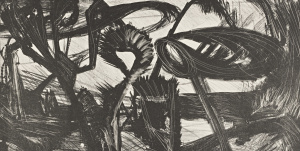Visual Essay: Body Techniques and Technologies of Human Touch at Atelier 17

Tamara Rey Patri (1920–2001). Detail of La Tempête. c. 1950. Lithograph. 11 ½ x 16 ¼ in. The Marty O’Brien Collection of American Art.
Unaffiliated with a single movement or school, Atelier 17 functioned as a vital meeting ground between Surrealism and what would become Abstract Expressionism, sharpening the broader artistic concerns of the era while intertwining them with the technical breakthroughs pioneered in the workshop. Founded in 1927 Paris by Stanley William Hayter and relocated to New York City in 1940 as World War II descended, the Atelier became a vibrant hub where European avant-garde strategies converged with an American context, radically shaping the trajectory of mid-century modernism.
While Surrealism and Abstract Expressionism form the expected backdrop, this visual essay proposes that experimental printmaking itself—through its distinct material and expressive properties—offered a parallel trajectory that painting could not. Historically, printmaking carried associations of automation and reproducibility, distancing the artist’s visible hand and challenging notions of originality and authenticity. Here, those qualities become generative rather than reductive: the process-driven, “mechanical” aspects of the medium become ways to grapple with embodiment and the shifting human condition in a world increasingly defined by technological transformation.
Housing one of the largest collections of this material, our holdings allow for the study of unexpected throughlines and themes that defined this watershed moment in printmaking: formal experimentation for its own sake, the embrace of new technologies and tools for mark-making, and a uniquely collaborative spirit as historical heavyweights and novices worked side by side to advance the medium.
These prints showcase not only the Atelier’s technical ingenuity […] but also how these innovations became tools for artists to navigate the existential and psychological currents of the time.
These prints showcase not only the Atelier’s technical ingenuity (such as simultaneous color printing, soft-ground etching, the use of power tools, and the layering of multiple traditional modes) but also how these innovations became tools for artists to navigate the existential and psychological currents of the time. The works reflect the disorientation of a rapidly industrialized and urbanized world, the traumas of global conflict, and the reconfiguration of how individuals moved through social and physical spaces. The plate itself emerges as more than a surface: it becomes a site where the mechanical and the organic meet, a field for recording a “dance” between process, gesture, and the unpredictable energy of the age in which the dynamic use of line and motion channels an emphasis on unrestrained movement and expressive force that resonates with the medium’s own physicality.
Throughout the selected prints, forms resembling human bodies appear to dissolve into the ground or reform from looping abstract gestures and frenzied lines. In some works, the figure is not depicted directly but implied physically through swift, assertive marks that trace the artist’s hand across the plate. Others employ Surrealist strategies of automatic drawing, in which the artist allows the tool to move unconsciously across the surface, absent of any preconceived image or plan. Rather than positioning these works as “lesser” counterparts to Abstract Expressionist painting, they reveal a distinct mode of process-based abstraction that centers on transformation, replication, automation, and the tension between control and surrender within the often destabilizing realities of mid-century modernity.